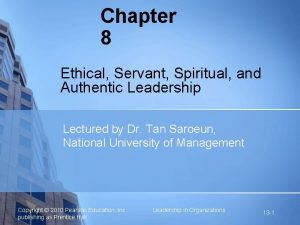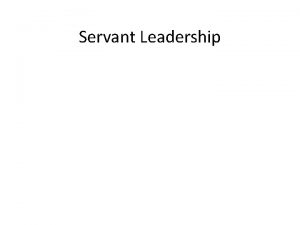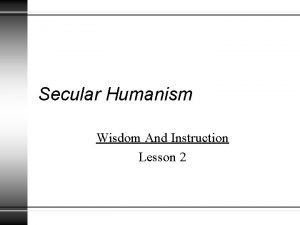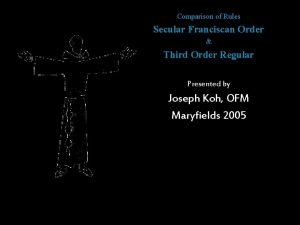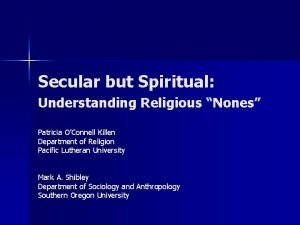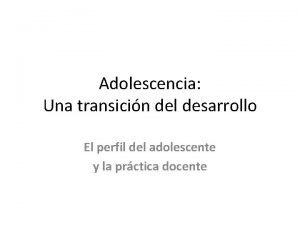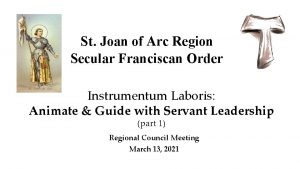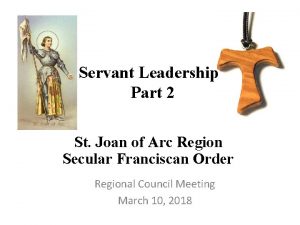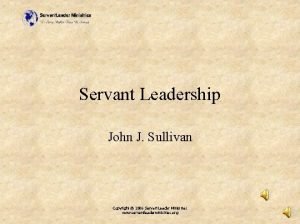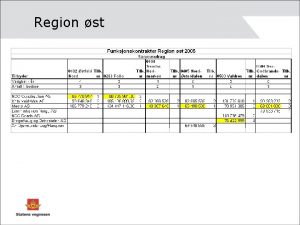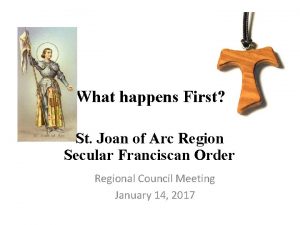Servant Leadership St Joan of Arc Region Secular









![and… John 13: 12 -16 So when he had washed their feet [and] put and… John 13: 12 -16 So when he had washed their feet [and] put](https://slidetodoc.com/presentation_image_h2/097ccce7c5f5efc8cc4138a4a00751cd/image-10.jpg)


























- Slides: 36

Servant Leadership St. Joan of Arc Region Secular Franciscan Order Regional Council Meeting January 13, 2018

The Prayer Before the Crucifix Most high, glorious God, enlighten the darkness of my heart and give me, Lord, a correct faith, certain hope, a perfect charity, sense and knowledge, so that I may carry out Your holy and true command.

What is Leadership the Secular Franciscan Order? OFS Rule 21 “On various levels, each fraternity is animated and guided by a council and minister (or president) who are elected by the professed according to the constitutions. Their service, which lasts for a definite period, is marked by a ready and willing spirit and is a duty of responsibility to each member of the community. Within themselves the fraternities are structured in different ways according to the norm of the constitution, according to various needs of their members and their regions, and under the guidance of their respective council. ”

General Constitutions Article 32 1. The ministers and councilors should live and foster the spirit and reality of communion among the brothers and sisters, among the various fraternities, and between them and the Franciscan family. They should, above all, cherish peace and reconciliation in and around the fraternity. 2. Rule 21 The ministers’ and councilors’ task to lead is temporary. The brothers and sisters, rejecting all ambition, should show love for the fraternity with a spirit of service, prepared both to accept and to relinquish the office.

So, what is “Servant Leadership? ” Francis did not use the term servant leader. When writing letters, Francis referred to himself as: “your lesser servant” “your little and looked down upon servant” “His servant and yours” “the least of the servants of God” “your servant and little one of the Lord” “your very little servant”

Later Admonition and Exhortation to the Brothers and Sisters of Penance (Second Version of the Letter to the Faithful) Francis wrote: “Because I am the servant of all, I am obliged to serve all and to administer the fragrant words of my Lord to them. ”

Leaders as servants is an ancient philosophy Some ancient passages refer to leaders as servants: The highest type of ruler is one of whose existence the people are barely aware. Next comes one whom they love and praise. Next comes one whom they fear. Next comes one whom they despise and defy. (Lao-Tzu, in the Tao Te Ching 570 BCE - 490 BCE) The king [leader] shall consider as good, not what pleases himself but what pleases his subjects [followers] The king [leader] is a paid servant and enjoys the resources of the state together with the people. (Chanakya, in his book Arthashastra 4 th. Century BCE)

Christian Tradition refers to Bible passages: Mark 10: 42 -45 : “Jesus summoned them and said to them, “You know that those who are recognized as rulers over the Gentiles lord it over them, and their great ones make their authority over them felt. But it shall not be so among you. Rather, whoever wishes to be great among you will be your servant; whoever wishes to be first among you will be the slave of all. For the Son of Man did not come to be served but to serve and to give his life as a ransom for many. ” The New American Bible, Revised Edition (NABRE)

The Christian tradition also quotes: John 13: 3 -5 “fully aware that the Father had put everything into his power and that he had come from God and was returning to God, he rose from supper and took off his outer garments. He took a towel and tied it around his waist. Then he poured water into a basin and began to wash the disciples’ feet and dry them with the towel around his waist. ” The New American Bible, Revised Edition (NABRE)
![and John 13 12 16 So when he had washed their feet and put and… John 13: 12 -16 So when he had washed their feet [and] put](https://slidetodoc.com/presentation_image_h2/097ccce7c5f5efc8cc4138a4a00751cd/image-10.jpg)
and… John 13: 12 -16 So when he had washed their feet [and] put his garments back on and reclined at table again, he said to them, “Do you realize what I have done for you? You call me ‘teacher’ and ‘master, ’ and rightly so, for indeed I am. If I, therefore, the master and teacher, have washed your feet, you ought to wash one another’s feet. I have given you a model to follow, so that as I have done for you, you should also do. Amen, amen, I say to you, no slave is greater than his master nor any messenger greater than the one who sent him. If you understand this, blessed are you if you do it. ” The New American Bible, Revised Edition (NABRE)

The modern term “Servant Leadership” Robert K. Greenleaf coined the term Servant Leadership in an essay titled “The Servant as Leader” published in 1970. He said, “ The servant-leader is servant first… It begins with the natural feeling that one wants to serve, to serve first. Then conscious choice brings one to aspire to lead. ” He continues: “That person is sharply different from one who is leader first, perhaps because of a need to assuage an unusual power drive or to acquire material possessions. ” And he concludes: “The leader-first and the servant-first are two extreme types. Between them are shadings and blends that are part of the infinite variety of human nature. ”

Greenleaf continued by saying: “The difference manifests itself in the care taken by the servant-first to make sure that other people’s highest priority needs are being served. The best test, and difficult to administer, is: Do those served grow as persons? Do they, while being served, become healthier, wiser, freer, more autonomous, more likely themselves to become servants? And, what is the effect on the least privileged in society? Will they benefit or at least not be further deprived? ”

Greenleaf - servant leader characteristics: Primarily: desire to serve Additionally: listening & understanding acceptance & empathy foresight awareness & perception persuasion conceptualization self-healing rebuilding community

Why answer the call to servant leadership? Chapter 3 of the OFS Rule challenges us to provide leadership in the order at all levels, that is local, regional, national and international levels. Those who answer that challenge: v seek a clear vision of the OFS life v guide others to that life v love our fellow Franciscans in all their different ways which then attracts others to join us v seek to live a Gospel-centered life of conversion

Reasons we are called to leadership include: v to pass on our Franciscan legacy v to be our Rule incarnate v To continue the work of our order begun by Francis Our task (or goal) is “to live a conversion-based, Gospelcentered life, bringing Franciscan values to bear in our contemporary setting. ” (Handbook for Secular Franciscan Servant Leadership, p. 3) This is our answer to the call today to “rebuild my church, ” as Franciscans before us have done and those who follow will also do. (Handbook for Secular Franciscan Servant Leadership, p. 3)

Our Models After Jesus was baptized he: § gathered followers § prayed § taught by word and action § was Patient § fostered collaboration § bound his disciples through love and the Spirit § prepared them to carry out his work § washed their feet “What I just did was to give you an example: as I have done, so you must do. ” (John 13: 15)

Our Models After his conversion Francis: § called his followers brothers § prayed § lived according to the Gospel § was patient § established ministers as servants § led by words & actions § acted on his beliefs § was courageous § developed a rule of life § wrote prayers and letters to encourage and instruct “Incline the ear of your heart and obey the voice of God. ” (Letter to the Entire Order )

Our Models Drawn by God & inspired by Francis’ as model & leader, Clare: § vision of living the Gospel § inspired others to follow Christ § prayed § wrote a Rule inspired by Francis’ Rule § described the role of the mother abbess like that of the friar minister § was courageous § wrote prayers and letters to encourage and instruct “For the Lord Himself not only has set us as an example and mirror for others, but also for our [own] sisters whom the Lord has called tour way of life, so that they in turn will be a mirror and example to those living in the world. ” (The Testament of St. Clare)

Call – Commitment - Vision Essential to Franciscan Servant 1. Leadership: Call to leadership is initiated by God 2. Those called make wholehearted response & commitment 3. Leader has or is open to receiving the vision necessary to serve in a servant leader capacity All three elements must be equally present for there to be individual and fraternal growth and well-being. “A fraternity’s vitality and growth of fraternal life is usually related to the absence or presence of these characteristics in its leaders. ” (Handbook for Secular Franciscan Servant Leadership, p. 8)

Commitment Free will Choice & Promise “Commitment involves a choice in the present concerning a promise for the future. ” (Handbook for Secular Franciscan Servant Leadership, p. 8)

Commitment Making this commitment, we surrender freedom, individualism and control. Because intention is pure, the vision becomes clearer. Then the highest form of commitment, faithfulness, becomes real and a way of life. For us, that is faithfulness to the Franciscan life of living out the Gospel through the Spirit gifted to us by God as Franciscan Servant Leaders.

Prayer as an attitude & desire to be connected to the heart of God, not something we do by rote or habit. As we become more rooted in God’s love, our call and work as leaders will grow as we seek to do the will of God. As we have heard so often: “He must increase, while I must decrease” (cf. John 3: 30)

Life-Giving Union (OFS Rule Article 1) Franciscan Servant Leaders = service to our fraternities “Mindful that [we] are bearers of peace which must be built up unceasingly, [we] should seek out ways of unity and fraternal harmony through dialogue, trusting in the presence of the divine seed in everyone and in the transforming power of love and pardon. Messengers of perfect joy in every circumstance, [we] should strive to bring joy and hope to others” (OFS Rule Article 19) Dialogue is the means to accomplish this vision.

Dialogue takes place when both people listen and are listened to in turn. Dialogue has an easy flow when we are communicating on shared interests and experiences. Dialogue is most difficult to achieve when there is a conflict of interest or ideas. Yet, this is when true dialogue is most needed.

Dialogue Remember Greenleaf’s questions that indicate if care is being taken by the servant leaders, two apply to dialogue: ü Do those served grow as persons? ü Do they, while being served, become healthier, freer, more autonomous, more likely themselves to become servants? If we can answer “yes, ” then we have grown our listening skills and used them to have genuine dialogues with sisters and brothers.

Dialogue Servant leaders must learn to put themselves aside in order to become aware of the needs of the fraternity. In doing so, Servant leaders allow themselves to become vulnerable by giving up the human tendencies to: o “own” one’s point of view o defend one’s ideas, actions and interests o question other’s motivation o grow anxious during the communication exchange When we undertake this difficult concept of true dialogue in relationship with others, we experience what Francis called “perfect joy. ”

Listening When using good listening skills, we: 1. put our thoughts & feelings aside to be present to another 2. relax in order to use our entire self 3. maintain eye contact 4. have an expression of interest on our face 5. Try to understand what is being shared at the deepest level 6. respond with care and concern 7. allow the person to finish before we respond 8. when responding, share what we heard so we’re sure we understand 9. Imitate Christ in His openness to others – the Spirit gives us guidance and strength

Shared Leadership Secular Franciscan fraternities use a model of shared leadership. Everyone is responsible for something, including leadership. OFS members are to contribute to the good of all rather than expect to be served by others in the fraternity. Everyone should feel accountable and a part of the whole because each one is contributing his/her talents and sharing the load. No one person has so many tasks that they feel burdened. A good leader is able to recognize others’ talents and delegates accordingly.

Leadership Tasks In addition to managing fraternity affairs, servant leaders are called to: 1. help develop a shared vision, goals and objectives. 2. Inspire the desire to live out the vision 3. Provide the skills to make it happen 4. Nurture and preserve unity in the fraternity 5. Promote renewal in the fraternity 6. Develop leaders

Leadership Styles Situational Leadership – practical approach that relies on the leader’s ability to match their style of leading to different situations and the people involved. It relies on the leader recognizing individuals’ talents and skills as well as levels of commitment. Four leader styles: Ø Directing – leader tells, no focus on support Ø Coaching – highly directive and highly supportive Ø Supporting – maintains & encourages, may share ideas ‘how to’ Ø Delegating – turns over responsibility to those being led

Leadership Styles A leader using Situational Leadership must be able to use each of the styles as needed based on competence and commitment of those being led. Competence = knowledge and skill Commitment = confidence and motivation Leaders select which style by recognizing the various combinations of competence and knowledge encountered as they lead. The style used changes as competence & commitment grow in those being led.

Situational Leaders use: Leadership Styles Directing – low competence and high commitment Coaching – some competence but low commitment Supporting – high competence but variable commitment Delegating – high competence & high commitment

Our Franciscan Response Each of us is called to servant leadership in the OFS. Each of us is called to live an active, prayer filled life in the secular world. OFS servant leadership is always rooted in on-going conversion We remember that Christ is the true leader and each day make our choice to follow. We share our gifts and encourage and enable others to also share their gifts.

Resources Ø The Rule of the SFO Ø General Constitutions of the Secular Franciscan Order Ø The New American Bible, Revised Edition (NABRE) Ø Francis of Assisi Vol. 1 of: Francis of Assisi: Early Documents Edited by Regis J. Armstrong, O. F. M. Cap. , J. A. Wayne Hellmann, O. F. M. Conv. , William J. Ø Francis and Clare: The Complete Words, by Regis Armstrong, O. F. M. Cap. and Ignatius C. Brady, O. F. M. New York: Paulist Press, 1982.

Resources Ø Hanbook For Secular Franciscan Servant Leadership copyright 2010, The National Fraternity of the Secular Franciscan Order in the U. S. A. , edited by Anne H. Mulqueen, OFS Ø Tao Te Ching (Ancient Chinese manuscript) credited to Laozi, 570 BCE - 490 BCE Ø Arthashastra (ancient Indian treatise) credited to Chanakya 4 th. Century BCE Ø The Servant as Leader” by Robert K. Greenleaf, published in 1970, Center for Servant Leadership

“May whoever observes all this be filled in heaven with the blessing of the most high Father, and on earth with that of his beloved Son, together with the Holy Spirit, the Comforter. ” (Blessing of St. Francis from the Testament )
 Difference between public servant and civil servant
Difference between public servant and civil servant Joan of arc accomplishments
Joan of arc accomplishments Joan of arc heretic
Joan of arc heretic Joan of arc timeline
Joan of arc timeline Servant theory
Servant theory Northouse leadership
Northouse leadership Followership and servant leadership
Followership and servant leadership Servant leadership vs followership venn diagram
Servant leadership vs followership venn diagram Servant leadership
Servant leadership អភិសមាចា
អភិសមាចា Servant leadership vs followership army venn diagram
Servant leadership vs followership army venn diagram Seven pillars of servant leadership
Seven pillars of servant leadership What we will cover today
What we will cover today Servant leadership webinar
Servant leadership webinar Servant leadership theory
Servant leadership theory The servant leadership triangle
The servant leadership triangle The servant theories
The servant theories What is servant leadership
What is servant leadership 12 principles of servant leadership
12 principles of servant leadership Arc emu88 com arc info 08 100008 html
Arc emu88 com arc info 08 100008 html Arc promoteur vs arc investigateur
Arc promoteur vs arc investigateur Minor and major arcs
Minor and major arcs Minor arc meaning
Minor arc meaning Secular humanism
Secular humanism Third order franciscan rule
Third order franciscan rule Huckel secular equation for cyclobutadiene
Huckel secular equation for cyclobutadiene What does secular mean
What does secular mean What is secular tv
What is secular tv Key events of the renaissance
Key events of the renaissance What does renaissance mean in music
What does renaissance mean in music Confucius the secular as sacred
Confucius the secular as sacred Values in the renaissance
Values in the renaissance What is a secular state
What is a secular state Secular
Secular Secular paganism
Secular paganism Secularism means
Secularism means Tendencia secular en la pubertad
Tendencia secular en la pubertad









